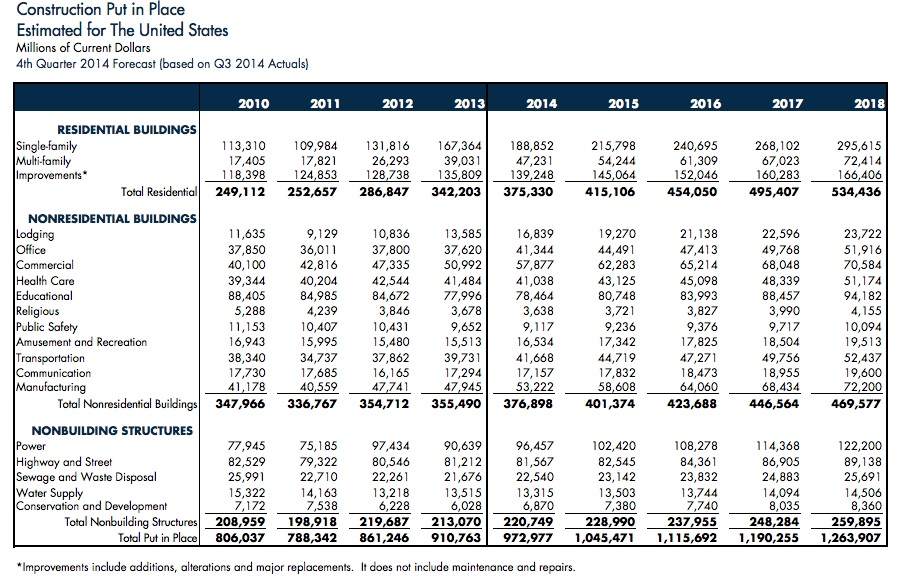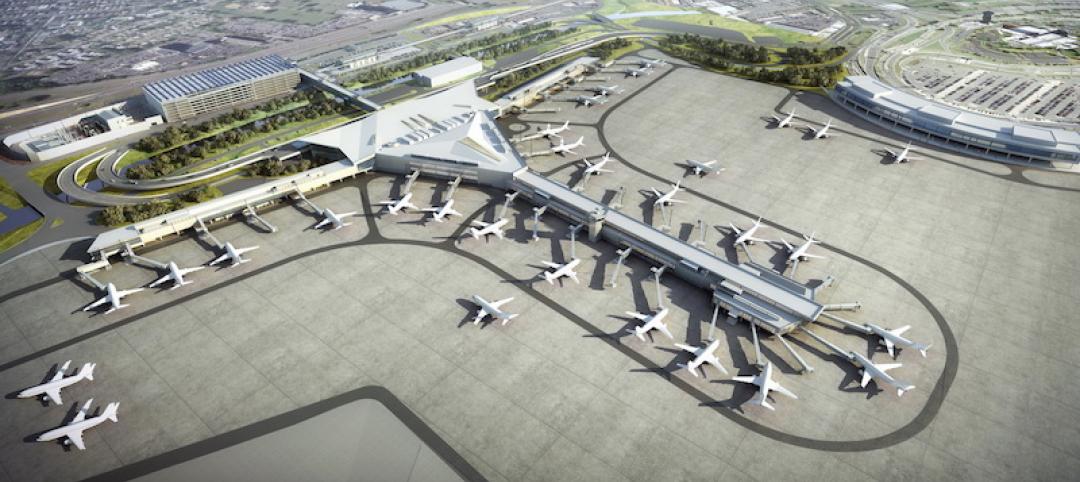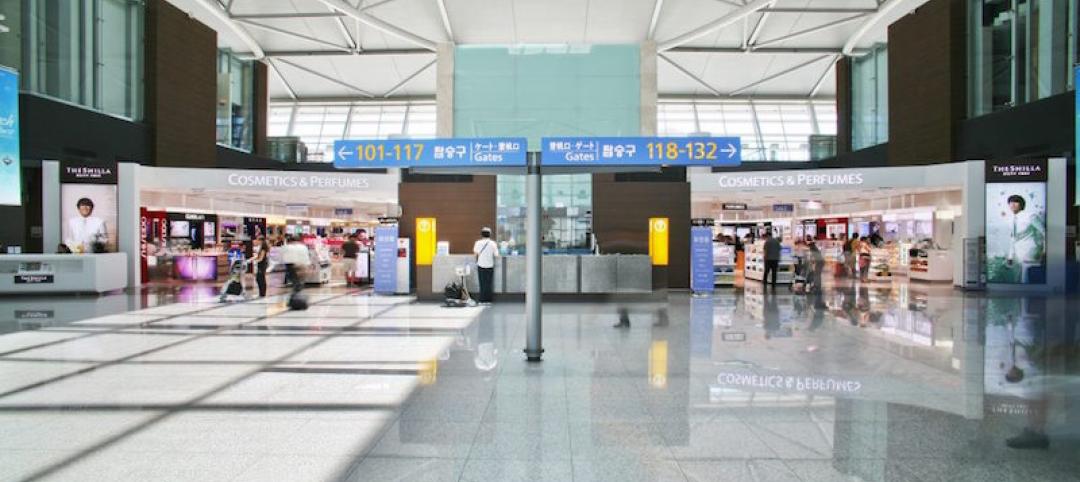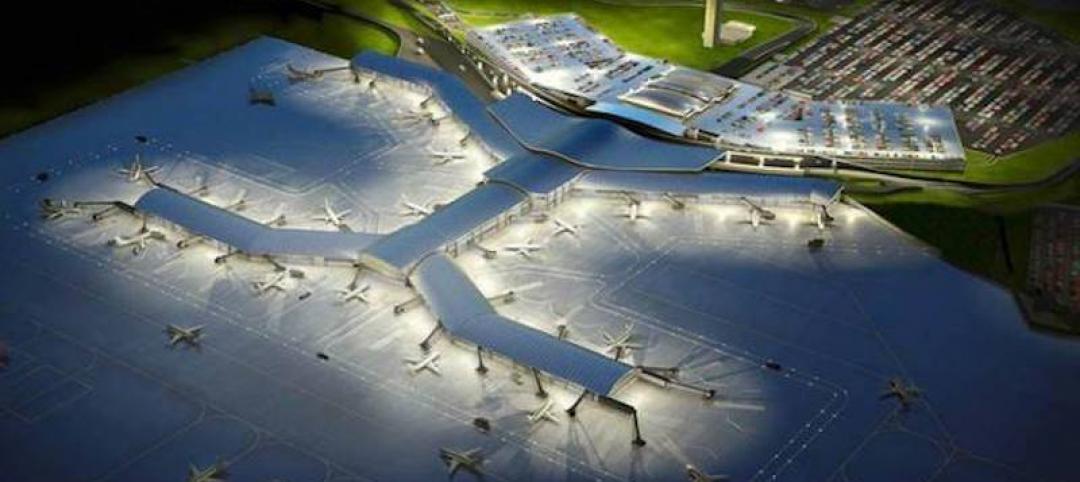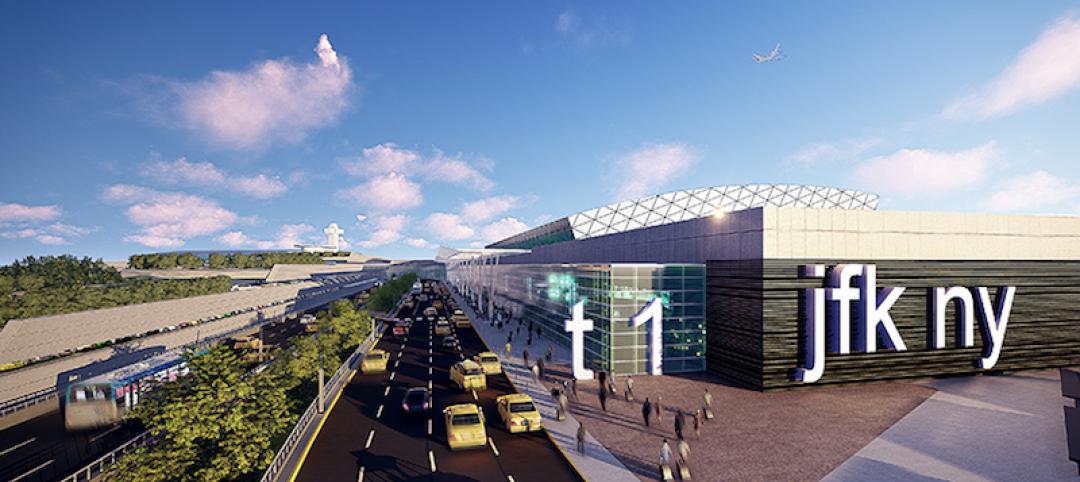Driven by a recovering economy, increasing demand for multifamily housing, and a manufacturing sector buoyed by robust oil and gas drilling and production, construction put in place (CPIP) in the U.S. grew by 7% to just under $973 billion in 2014, according to estimates by FMI, the Raleigh, N.C.-based consultant and service provider for the construction industry.
FMI’s Construction Outlook for the fourth quarter projects steady, single-digit annual growth rates through 2018, when CPIP is expected to reach $1.264 trillion. FMI tempers its predictions, though, by pointing out that declining oil prices could hobble future construction budgets. And the “wild card” that could affect the construction industry next year and beyond is “what the new Congress will (or will not) do,” and how its actions impact sectors dependent on government spending, notably education.
CPIP for nonresidential buildings, a subset of the total construction value, rose 6% to $376.9 billion in 2014. FMI’s Nonresidential Construction Index “remains solidly in positive territory.” And a full percentage point of that growth is attributable to an 11% gain in the manufacturing sector, to $53.2 billion. But FMI cautions that oil and gas production within this sector is “highly cyclical,” which may explain why FMI lowers its 2015 growth projection for manufacturing to 10%, and anticipates lower growth rates in the proceeding three years.
Lodging is another area that has benefited mightily from the country’s economic rebound. Its CPIP soared by 24% to $16.8 billion in 2014. FMI cites Lodging Economics, which noted that hotel construction hit a five-year high in the third quarter of 2014. And with occupancy rates still ascending, FMI foresees double-digit CPIP growth in 2015 and 2016.
The Commercial sector did “better than expected” when its CPIP rose by 14% to $57.9 billion in 2014. Drivers in this sector include lower unemployment rates, a stabilizing housing market, and still-low inflation. But FMI expects that growth to tail off in the coming years, as retail remains in a transformative stage of needing to be more responsive to consumers to keep them coming to their stores while, at the same time, integrating those customers’ online sales activities. (The Census Bureau estimated that while retail and food service sales barely increased through the first nine months of 2014, nonstore retailers increased by 9.2%.)
Office vacancy rates last year dropped below 16% for the first time since 2008, according to the commercial real estate consultant and investment manager Jones Lang LaSalle. And the prospect of a steadier stream of tenants helped push the office sector’s CPIP to a 10% increase in 2014. FMI sees that pattern continuing in 2015, but then expects growth to soften in the out years.
A 1.4% increase in freight rail-car loadings was just one manifestation of how an improving economy is boosting the fortunes of the nation’s Transportation sector, whose CPIP jumped 5% in 2014, and is expected to grow by 7% in 2015 to $44.7 billion. FMI points out there are several urban metrorail projects in the works. The omnibus spending bill that Congress passed in December includes $500 million for the Department of Transportation’s TIGER (Transportation Investment Generating Economic Recovery) grant program. And construction within the airline industry should benefit from a 2.2% annual growth rate in carrier passengers the Federal Aviation Administration forecasts over the next 20 years.
The Amusements and Recreation sector is being charged by a spurt in stadium and arena construction around the country. But in light of three casino closings in Atlantic City, N.J., in 2014, the gaming industry within this sector, says FMI, is “rethinking” its facilities for greater appeal to broader customer bases, including “the combination of multiple entertainment and shopping into one park.” Nevertheless, “casino plans are underway in a number of states, including New York, Pennsylvania, Maryland, Florida and Ohio, with some investors coming from offshore,” notes FMI, which expects annual CPIP growth in the sector to fall between 5% and 7% over the next four years.
A number of nonresidential building sectors were on the downswing in 2014. While health care’s CPIP was off by only 1%, there’s a lot of uncertainty about this sector’s future and that of the Affordable Care Act, with a Republican Party that has adamantly opposed that law controlling both houses of Congress. But FMI still thinks this sector could grow by 5% in 2015 to $43.1 billion. “Ambulatory health care centers and renovations to existing facilities in order to be competitive and keep up with changing technologies and patient needs will continue to be the focus for construction.”
The Communications sector’s CPIP stood at negative 1% 2014, as much of this industry’s build out of high-speed Internet infrastructure has been completed. FMI predicts a modest rebound for this sector in 2015, as “the current trend is for building more data centers and beefing up security and privacy against potential interlopers and severe weather events.”
Constrained state and local budgets were mitigating factors in the Education sector’s paltry 1% CPIP gain in 2014. That CPIP, at $78.5 billion, was still the highest among any nonresidential building sectors. But since the recession, “it has been a difficult battle [for Education] to get back to previous levels of spending,” FMI observes. However, with student enrollment expected to expand by 2.5 million over the next four years, municipalities and states are starting to loosen their purse strings again to fund school construction and renovation projects. FMI projects low-single-digit CPIP growth for the sector over that period, with a greater emphasis on design flexibility and energy efficiency.
Despite the fact that the country’s jails and prisons are bursting at the seams, the CPIP for the Public Safety sector was off by 6% in 2014. Still, FMI foresees modest growth in this sector, especially as private firms assume more control within the U.S. penal system. The private prison industry, which operates 5% of the country’s 5,000 prisons and jails, is growing at a 30% annual rate.
Related Stories
Giants 400 | Oct 3, 2017
Top 30 airport engineering firms
AECOM, Burns & McDonnell, and Arup top BD+C’s ranking of the nation’s largest airport sector engineering and EA firms, as reported in the 2017 Giants 300 Report.
Airports | Sep 11, 2017
Terminal modernization: Why bother? Part I
A terminal modernization program can be a complicated and expensive task that airport operators may be hesitant to undertake unless necessitated by demands for increased capacity. This is the first post in our series examining why airport operators should bother to upgrade their facilities, even if capacity isn’t forcing the issue.
Hotel Facilities | Jul 5, 2017
It only took 26 days to complete construction on the Crowne Plaza Changi Airport hotel extension
PPVC techniques allowed the project to save time and manpower.
Airports | Jun 26, 2017
Newark Liberty International Airport breaks ground on $2.4 billion redevelopment project
The project includes a new 1 million-sf terminal building with 33 domestic aircraft gates.
Building Team Awards | Jun 8, 2017
Missing link: Denver International Airport and Transit Center
Gold Award: A new mixed-use transit center fulfills Denver’s 28-year plan to improve access to the nation’s fifth-busiest airport.
Airports | May 15, 2017
Five trends for airport retail
CallisonRTKL Vice President Kevin Horn pinpoints how travel retail is changing dramatically.
Reconstruction & Renovation | Mar 16, 2017
Pols are ready to spend $1T on rebuilding America’s infrastructure. But who will pick which projects benefit?
The accounting and consulting firm PwC offers the industrial sector a five-step approach to getting more involved in this process.
Airports | Feb 23, 2017
New Orleans Airport to add five additional gates and $110 million to current expansion
The project is being hailed as the city’s most transformative since the construction of the Superdome.
Projects | Jan 25, 2017
Trump prioritizes infrastructure projects, as rebuilding America is now a hot political potato
Both parties are talking about $1 trillion in spending over the next decade. How projects will be funded, though, remains unresolved.
Airports | Jan 17, 2017
JFK Airport set for $10 billion renovation
In addition to the airport itself, the overhaul will also improve road and rail access to meet projected passenger growth.



